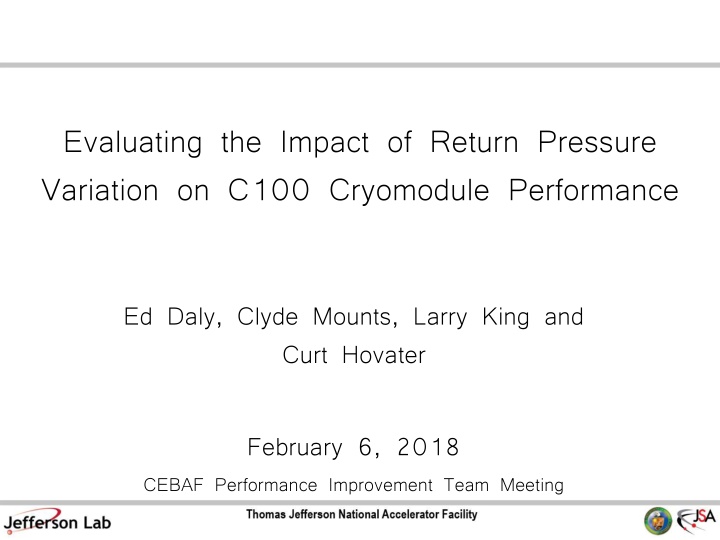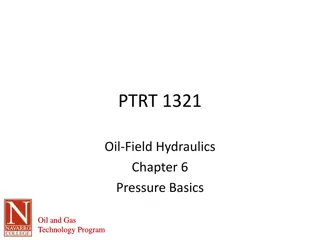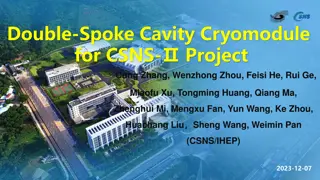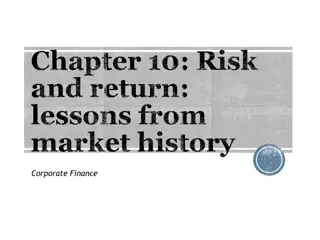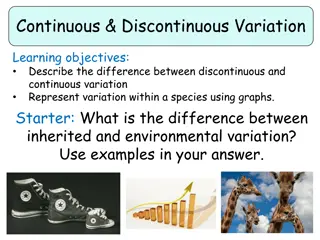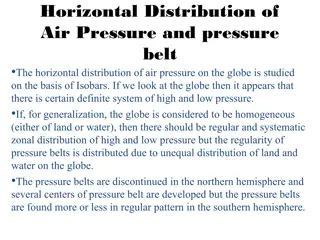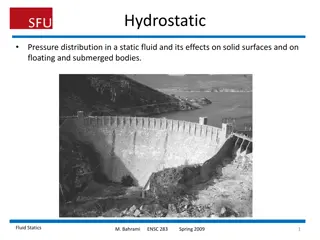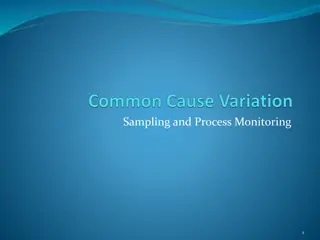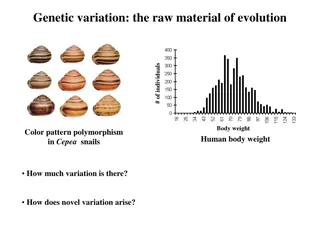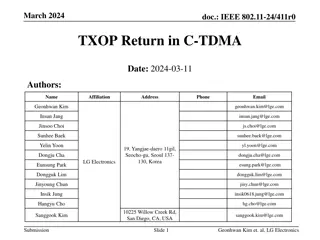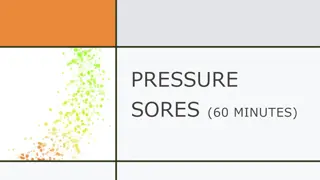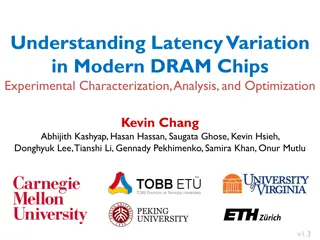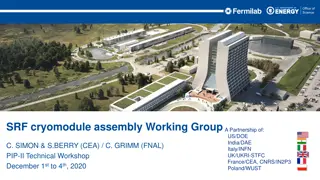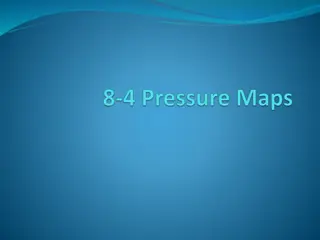Impact of Return Pressure Variation on C100 Cryomodule Performance
The performance of SRF cavities, specifically the C100 Cryomodule (CM), is influenced by the local surface resistance, bulk Nb temperature, and pressure variations. This study evaluates how return pressure variation affects the heat transfer limitations within the C100 CM, impacting cavity performance. By comparing the C100 vs. original CEBAF helium vessel design and analyzing critical heat flux in superfluid helium, the research explores ways to enhance performance by understanding the impact of return pressure on the system.
Download Presentation

Please find below an Image/Link to download the presentation.
The content on the website is provided AS IS for your information and personal use only. It may not be sold, licensed, or shared on other websites without obtaining consent from the author.If you encounter any issues during the download, it is possible that the publisher has removed the file from their server.
You are allowed to download the files provided on this website for personal or commercial use, subject to the condition that they are used lawfully. All files are the property of their respective owners.
The content on the website is provided AS IS for your information and personal use only. It may not be sold, licensed, or shared on other websites without obtaining consent from the author.
E N D
Presentation Transcript
Evaluating the Impact of Return Pressure Variation on C100 Cryomodule Performance Ed Daly, Clyde Mounts, Larry King and Curt Hovater February 6, 2018 CEBAF Performance Improvement Team Meeting
Introduction Introduction Performance of SRF cavity performance depends in part on the local surface resistance a function of the bulk Nb temperature Surface temperature is maintained by convective heat transfer into the superfluid helium (SFHe) surrounding the cavity Dissipated RF power is conducted through the SFHe to the liquid-vapor interface where helium gas evolves Gas is pumped away through the cryomodule (CM) internal piping into the u-tubes and then into the return transfer line. Saturated pressure at the liquid vapor interface determined by the local gas evolution rate and the piping sizes sets the local bath temperature Local pressure directly impacts the cavity performance In In the C100 CMs, there is pressure the C100 CMs, there is pressure- -dependent heat transfer limitation due to its particular internal piping limitation due to its particular internal piping configuration dependent heat transfer configuration
C100 vs Original CEBAF Helium Vessel C100 vs Original CEBAF Helium Vessel For the original CEBAF CMs, each cavity pair is immersed in SFHe inside the 24 diameter helium vessel Large area for pumping away helium gas C100 has individual helium vessels and helium piping Eliminates seals between the cavity vacuum and the helium bath Original CEBAF CMs suffered from some number of superfluid leaks Large area for pumping away helium gas Helium enters the C100 HV through the fill line from the bottom directly below the center cell and exits through the riser or chimney directly above the center cell.
C100 HV Helium Volume vs. Liquid Level C100 HV Helium Volume vs. Liquid Level Readback Readback
C100 CM Cut C100 CM Cut- -away away Return header is normally just below half full 92% liquid level readback
Critical Heat Flux in Superfluid Helium Critical Heat Flux in Superfluid Helium SFHe is an excellent conductor of heat up to a critical heat flux beyond which the properties change dramatically transition from liquid to gas occurs Empirical relationship observed in experiments in narrow channels and internal flow configurations Relatively strong function of bath pressure and temperature and weak function of length The critical heat flux in saturated liquid at 2 K is two times larger than at 2.1 K
Specifications for Bath Temperature and Pressure Specifications for Bath Temperature and Pressure For C100 cavities, Qo value is 8 x 10^9 at 19.2 MV/m 27 W dissipated in each cavity; 3 W for coupler; Total = 30 W Design value for power dissipation was doubled and the lines were sized to avoid any type of limitation in the heat flow due to the critical heat flux. Interface point for the CM pressure was defined as 0.0375 atm at the bottom of the return bayonet in the end can assuming a total design heat load of 300 W Pressure corresponds to a temperature of 2.07 K Critical heat flow for a single riser is 65 W; More than 500 W for the CM As the bath pressure rises, the critical heat flow is reduced. If the bath pressure rises to 0.044 atm, or about 2.13 K, the critical heat flow is about 30 W per cavity Neglecting increased surface resistance due to increase BCS losses, operating a C100 CM set at design gradient at this bath pressure would cause the critical heat flux to be exceeded in the riser. Operating cavities at higher bath pressure increases BCS losses which adversely impacts Qo values used by LEM for machine set-up The actual dissipated power could be ~50% larger than computed by LEM.
Critical Heat Flow Critical Heat Flow HV Riser HV Riser & Pressure & Pressure vs Temperature vs Temperature
0L04 - Estimation of Pressure in Helium Bath 0L04 is a C100 0L04 is a C100- -style CM located in the CEBAF Injector style CM located in the CEBAF Injector Use known heater power settings to determine when the transition was occurring by observing the change in liquid level (LL) readback At measured pressure of 0.041 atm, a heater heat of 142 W was applied uniformly over the eight cavity heaters The LL readback was stable. Ramped Heater heat until LL readback fluctuated Measured pressure was 0.0435 atm Heater heat was 240 W, or 30 W per cavity 30 W corresponds to bath temperature and pressure of 2.13 K and 0.044 atm Using the cavity heaters and the LL as an indicator, the local Using the cavity heaters and the LL as an indicator, the local bath pressure can be estimated. bath pressure can be estimated.
Liquid Level Liquid Level r readback eadback becomes unstable at transition becomes unstable at transition Valve Position Pressure Heater Ramping Liquid Level
Cavity Performance (Microphonics Workshop Talk by C. Mounts) An additional set of measurements was made to determine if resistive heat, RF heat or both causes any type of detuning instability that would affect RF performance. First the heater heat was set to 200 W while monitoring the cavity detune angles (TCDETA). As the resistive heat was ramped down, the detune oscillations decreased. At a value of 50 W, the detune angles returned to expected amplitudes. Then RF was turned on in the cavities while monitoring the liquid level and JT valve position. The cavity gradients were increased. At about 80 watts of dissipated power (87 MV), the detune instability began. This persisted and increased in magnitude with increasing gradients up to a heat load of about to 168 watts The gradients were then ramped down and the detune oscillations abated.
Addition of Pressure Transducers Measurements on 0L04 show that the mass flow from each CM can affect local pressures and the overall pressure drop in the cryogenic distribution system Absolute pressure is lowest at the inlet to the cold compressors and highest at the ends of the linacs. Proposal: Place one sensor near the tee in each linac to monitor the exhaust pressure from each linac adjacent to the inlet to the CHL cold compressors The change in pressure at this location will be related to the total mass flow coming from the linacs. Place sensors at the ends of each linac to monitor the highest absolute pressure. For the north linac, use the injector modules All of the sensors would be placed on the CM end can nearest the desired location. Existing purge lines enable the installation of the sensors using VCR fittings. Use calibrated sensors that can be verified on the benchtop to understand any systematic differences For installations with a C100 CM, the heater and liquid level response can be used as a cross check against pressure readbacks. Over time, these six pressures can be monitored to ensure that operating limits for individual CMs are maintained.
Summary C100 CM thermal performance (ability to remove cavity dissipated power) is dependent on local bath pressure Exceeding critical heat flux in riser causes instabilities that can be observed in LL readback values and cavity detune angles Plan implemented for monitoring pressure at key points in the cryogenic distribution system provides feedback on CM operating conditions
